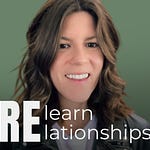"You have anxious attachment."
It was 2018, and I was sitting uncomfortably next to my now ex-husband when the therapist dropped his "diagnosis" of our issues.
"He's avoidant. Read the book Attached."
He said it so flippantly and matter-of-factly as if he had just solved the puzzle of why our marriage was burning down.
He hadn’t solved anything; he had just given us labels—labels that I would spend the next three years detaching myself from.
I have a beef with how many practitioners use attachment theory.
As you listen to this podcast, I want you to consider that attachment theory is a helpful tool, not a diagnosis.
“The quality of your life ultimately depends on the quality of your relationships.”
―Esther Perel
Key Takeaways:
Attachment Styles as a Continuum: Avoidant, anxious, and secure are points on a spectrum, not fixed labels.
Labels as Limiting: Labels can justify unhealthy behaviors; it's better to view attachment styles with curiosity and growth in mind.
Childhood Influence: Your attachment style is shaped by early experiences with caregivers but can change through self-awareness.
Secure Attachment: Formed through consistent, responsive caregiving. It leads to trusting relationships, self-esteem, and emotional sharing.
Anxious Attachment: Results from inconsistent caregiving, leading to fear of abandonment and distress in relationships.
Avoidant Attachment: Develops when needs are neglected, causing emotional distance and intimacy issues.
Self-Awareness for Change: Understanding why you've developed certain attachment tendencies helps heal and change those patterns.
Actionable Insight: Inner child work is the key to healing attachment wounds and moving toward secure attachment.
Go Deeper:
I’m obsessed with inner child work for this reason: it changed my relationships.
Before understanding the why behind my behaviors, I lived in automatic mode.
In relationships, that looked like:
Getting emotionally overwhelmed in conflict and shutting down.
Allowing myself to be treated like a doormat because I thought having boundaries was mean.
Being manipulative in an attempt to get my needs met instead of communicating clearly and directly.
Overthinking everything I wanted to say and rehearsing possible responses in my head.
After doing inner child work, I have access to what I call Intentional mode.
In relationships, that looks like this:
Experiencing and expressing my emotions in a healthy, regulated way.
Having healthy boundaries and receiving respect in my relationships because I hold my boundaries.
Asking for what I want and need directly.
Getting back into my body when I find myself living in my head.
If you’re tired of:
Letting your emotions run the show,
Overthinking what to say, or
Being disrespected,
I’d love to guide you through my Blueprint Awareness Method.
Message me (or email me at lilly@lillyrachels.com) the word “Blueprint” to learn more.















Share this post